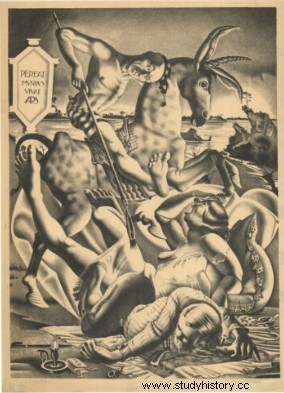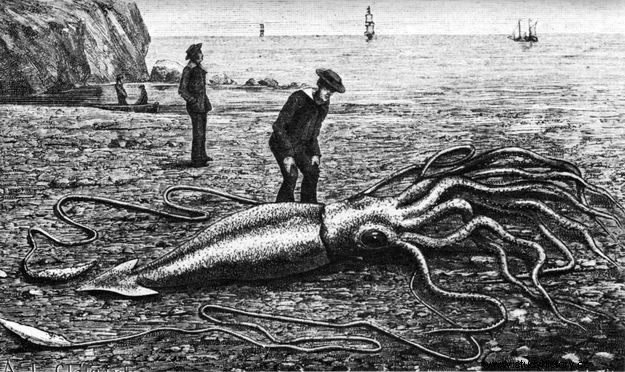People have cataloged and described nature for centuries. However, they did not always do it based on facts - very often, instead of reliable information, readers found nonsense sucked out of their fingers ...
Bestiaries from ancient times, the Middle Ages and even later historical periods abound in amazing creatures like unicorns, dragons and salamanders living in fire. Today we know perfectly well that such animals do not exist, but ... for some, a good story is better than the truth. These are completely real animals that were made into real monsters for the sake of sensation.
Monstrous tentacles
One of the most terrifying and imaginative animals are, of course, the octopus, cuttlefish and squid - they move in a strange way, soft, looking "foreign". It's not hard to guess where the terrifying myths about Kraken or Scylla came from after all, all you need to do is change the scale. The monster is ready.
Pliny around 77 AD, however, decided to describe these sea creatures more substantively. The translation of his "sighting" of octopuses says:
For if it encounters divers under the water or survivors of a shipwreck, it launches an attack:it grasps them firmly with its claws or arms, as if trying to wrestle with them, it starts sucking on them with empty hollows and sucks and sucks their blood for so long (as if it were putting bubbles on their bodies in many places at once) that eventually emptied them completely.
Such drastic scenes can be attributed to some extent to the author's life. However, one and a half thousand years after the author of "Natural History", octopuses were still ascribed unlikely traits.

Fantastic animals have aroused the imagination for centuries.
Ulisse Androvandi, an Italian naturalist and physician, claimed, for example, that they are stronger than an eagle and more ferocious than a lion:
These voracious creatures mainly hunt for fish and crustaceans, but sometimes they also eat fruit (they especially like figs), olive oil, occasionally people, and sometimes even their own arms "- we read an excerpt from his work in Caspar Henderson's book" The Book almost impossible animals.
The mystery of the shells
Sometimes you don't even need a living creature to create an amazing story - all you need is a fossil! So while the philosophers of Greece and Rome attributed the found remnants of ammonite shells quite close to the truth (they generally believed that the shells of sea animals gradually turned into rocks), later Christians had a much more "interesting" opinion.
Since the world has only existed according to Scripture for a few thousand years, the fossils could not be too old. One theory is that they formed spontaneously in rocks because nature tried to form itself like God's creation. Other researchers have argued, however, that the preserved shapes are the remains of animals that remained on the water-covered mountains during the Flood.
The relationship between humans and animals was generally not the best during the Middle Ages. For example, monkeys were considered devilish creatures at the time, as were goats and cats . Meanwhile, salamanders - as each animal is a reflection of a certain element of God's plan - existed, according to the people of that time, on fire. Why? As Saint Augustine wrote:
The salamander is proof enough that anything that burns does not burn, and likewise souls in Hell burn with an eternal flame.
Although there is a fairly obvious distortion of the relationship between fact and intended message, small amphibians will always be associated with a dangerous element.

Squid
The attentive honey badger
Some animals are begging for attention and ascribing amazing qualities to them. One of the most legendary species is the honey badger ratel that lives in the plains of East Africa. As early as Herodotus, in the 5th century BC, wrote about an animal larger than a fox, but smaller than a dog that gouges sand in search of gold . According to the well-known historian, the daredevils can take away the treasures of the pet, but you should be very careful at the same time:it's best to attack the fastest camel and run away quickly, before the honey badger realizes the situation. He is incredibly fast and fierce - that's exactly right, because these little creatures are known for winning battles with lions!
Herodotus wrote 2,500 years ago. Meanwhile, the honey badgers obviously don't get enough fame:in 2007, there was a scandal in which they played a major role. In war-torn Basra, rumors began spreading about animals with the head of a monkey and a dog's torso, wreaking havoc on cows at night and breaking into houses. According to the Basris, they were specially trained British badgers, used for psychological warfare ... It got to the point that a spokesman for the British army had to deny the rumors in the media. "We strongly deny that we released cannibal badgers into the city," said Mike Shearer. As you can see, it doesn't take much for a legend to come to life in the minds of confused people ...

Griffin
History must sell
Some animals acquire supernatural qualities in human eyes due to a lack of understanding or shocking abilities. Others are credited with magical properties in order to profit from them. Unfortunately, an example of such a process is perhaps the mythical unicorn. Regardless of where this creature came from, its single horn could be nothing more than a metaphor for male potency, and when powdered it was supposed to act as the best aphrodisiac . No wonder then that for the "real" unicorn horn Pope Clement VII paid six times more than Michelangelo's remuneration for the execution of the frescoes in the Sistine Chapel ...
Bibliography:
- British blamed for Basra badgers. BBC, July 12, 2007.
- Hammond, N.G.L., History of Greece. Warsaw:State Publishing Institute, 1973.
- Henderson, C., Book of the Nearly Impossible Animals. Marginesy, Warsaw, 2018.
